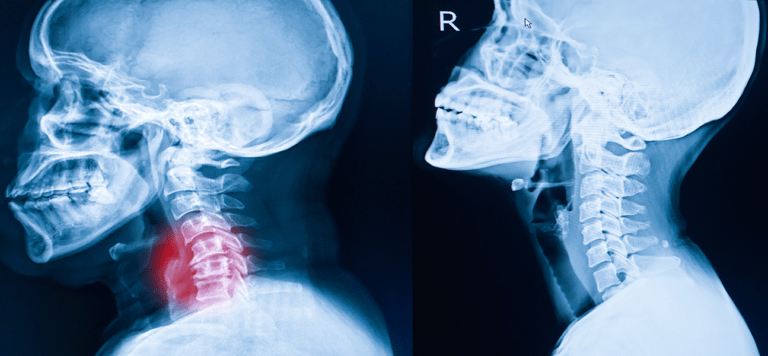Cervical arthritis, also known as cervical spondylosis or arthritis of the neck, is a condition affecting your neck’s joints and discs. It is a type of arthritis caused by neck cartilage and bone deterioration. Over time, this degradation could lead to painful and stiff joints.
It is expected to experience symptoms of cervical arthritis as you age. Each person may experience different symptoms. Some may have mild discomfort, while others may have more severe neck stiffness and pain, making it difficult to move their neck.
Even though the condition is more common as people age, not everyone will have symptoms. For those who experience it, some therapies can help control the discomfort and keep you active.
If you suspect you might be dealing with cervical arthritis, seeking a professional evaluation is crucial. Momentum Medical specializes in diagnosing and treating cervical arthritis, offering personalized care plans to manage your symptoms and enhance your quality of life.
Don’t let neck pain hold you back. Contact Momentum Medical today to discuss your treatment options and take the first step towards relief.
What Causes Cervical Arthritis?
Cervical arthritis stems from the wear and tear of the neck’s joints, with aging being a significant contributor. Our joints naturally weaken as we age, increasing our susceptibility to conditions like cervical arthritis.
Accidents and injuries affecting the neck can also lead to cervical arthritis. Whether it’s a sports injury, a fall, or an accident, any impact that harms the neck joints may trigger the development of this condition.
Genetics also plays a role in the risk of developing cervical arthritis. It often runs in families, suggesting that if you have a family history of arthritis, you might be more predisposed to experiencing it yourself.
Potential Complications
If cervical arthritis is not addressed on time, it can worsen and lead to nerve compression. When this happens, numbness can be felt in the neck region.
Movement restrictions brought on by excruciating pain or loss of function in body parts controlled by damaged nerves can result in disability.
Another complication that cervical arthritis can lead to is chronic pain. People experiencing chronic pain can feel devastated, and they may struggle with everyday life as the pain keeps making their lives miserable.
Getting A Diagnosis
Checking on medical history is done to determine where the illness originated from.
Next, a physical examination is conducted. The doctor checks for any signs of neck stiffness or difficulty moving the neck. They also look for tenderness in the area. These initial steps are crucial for guiding further tests.
Imaging Tests
Better imaging tests are performed, and X-rays are a standard method of this approach to diagnose cervical arthritis. Bone spurs and joint spacing are visible in X-rays. This can be a sign of cervical arthritis.
On the other hand, magnetic resonance imaging (MRI) scans offer highly detailed images of soft tissues, such as discs and bones. Doctors recommend MRI scans for detailed images that allow them to view both tissues and bones. This gives them a clearer understanding of what’s happening to the bones and joints.
What Are The Symptoms?
Many different symptoms can accompany cervical arthritis. These may include:
Common Signs
- Neck pain and stiffness
- Limited neck range of motion
- A clicking, popping, or grinding sound when you move your neck
Less Common Symptoms
- Vertigo
- Headache
- Palpitations
- Nausea
- Abdominal discomfort
- Tinnitus
- Blurred Vision
Severe Indicators
In severe cases, symptoms go beyond discomfort and pain.
- Numbness in arms or hands
- Weakness that impairs balance and grip strength. These symptoms require immediate medical attention.
- Severe neck pain that doesn’t improve with rest could indicate a significant issue within the cervical spine area.
If you notice these severe indicators, consult a healthcare provider promptly.
Understanding these symptoms helps identify cervical arthritis early on. Early detection allows for more effective management of the condition.
How Is It Treated?
Depending on the severity of the problem, there are many options for treating cervical arthritis. Here are a few typical therapeutic approaches:
Physical Therapy
One successful treatment for cervical arthritis is physical therapy. Effective neck exercises can help relieve pain and stiffness by releasing the muscles and joints. Based on the patient’s needs, physical therapists usually design a personalized exercise program and follow through on it regularly.
By following a physical therapy plan, patients can improve their mobility and reduce the discomfort caused by cervical arthritis.
Medication Use
Prescription drugs such as muscle relaxants to ease muscle tension and spasms and anti-inflammatory medications to lessen swelling and pain can help manage cervical arthritis.
These medications should only be taken as directed by a physician, given their potential for side effects and interactions with other medicines. Talking to your doctor about any worries or inquiries you may have regarding medication is crucial.
Surgical Options
For patients with arthritis in the neck who are not responding to oral medicines or non-invasive treatments, surgery is the last resort. Doctors recommend this solution if they have tried all the means and none are effective. Preparedness is essential when you plan to undergo surgery.
Now that you understand cervical arthritis, you can feel more confident about seeking treatment. Contact Momentum Medical to see how we can help improve your condition.
FAQs
What are the worst symptoms of cervical spondylosis?
Extreme symptoms of cervical spondylosis are more common among older people, as the deterioration of joints and bones happens during this period.
How serious is arthritis of the cervical spine?
Cervical arthritis can lead to complications if not treated immediately. Disability and life discomfort can be the worst outcomes of this condition. Because the cervical joints are necessary for mobility, the entire body may be affected if one of them malfunctions.
What is the treatment for cervical arthritis?
Both non-surgical and surgical treatments can be recommended to ease the pain caused by cervical arthritis. Doctors prescribe medicines that have anti-inflammatory effects and muscle relaxants to address pain and swelling. If arthritis can not be remedied by medicine or therapy, your doctor may suggest an operation.

